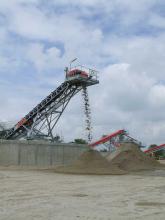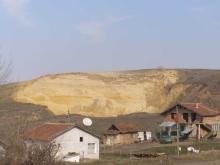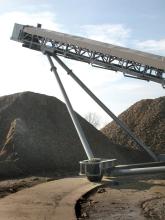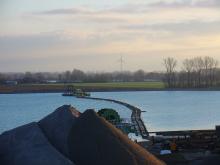
Switzerland's aggregates market is highly influenced by environmental pressures and by its location. Lisa Russell reports
It is a well-known fact that Switzerland does not have a wide range of raw material resources suitable for extraction. No lignite, gold or petroleum are mined or produced on Swiss territory. On the other hand, Switzerland is "rich in rocks," said André Renggli, who is president of the Association of the Swiss Aggregate & Concrete Industry (which is known by its German abbreviation FSKB) and Griston Group CEO.
About a quarter of the national territory consists of uninhabitable mountains, and the remainder is densely populated. The facilitation and securing of aggregate supplies obtained from raw material stocks is therefore a particularly tough challenge and is the central task of the association.
"But the extraction of raw materials from gravel pits and quarries in particular is becoming increasingly difficult," said Renggli. "Although this involves only temporary disturbance of the landscape, opposition to such extraction projects is increasing." All in all about 50million tonnes of virgin aggregates are produced annually in Switzerland. "About 90% of the material produced in Switzerland is gravel," said FSKB director Martin Weder.
The gravels were transported during the ice ages from the Swiss mountains to the plains where they lie in deep deposits. The area between Lucerne, Zurich and Bern is the most important area for industry and here the layers are between 20m and 40m deep, giving extensive resources close to where they are most needed. "In other areas, you only have about 15m," said Weder.
Several companies also take material out of Swiss lakes such as Lucerne or Neuchatel. There are also some sites in the mountains that produce gravel aggregates as well as crushed rock aggregates, which account for perhaps 5million tonnes a year and tend to be used for special applications such as rail ballast.
About two thirds of the aggregates materials demand is for concrete production, particularly in cities. The huge Gotthard Base Tunnel construction project has also been consuming a lot of concrete, creating an important market for the sector.
Despite the global recession, business has been quite smooth in Switzerland compared with other European countries, said Weder. There are, however, some forecasts that the problems might arrive late in 2011 or in 2012, though predictions differ.
"What's really been hitting us is the Euro exchange rate to the Swiss Franc," said Oliver Osswald,
Economic and environmental factors mean that imports play an key role close to all borders. "The material coming in from Italy, Germany and France is substantially cheaper than from within Switzerland," said Weder. Some material comes in by river, above all by the Rhine, bringing its costs down still further.
In Basel, Weder estimates that 90% of material is imported from Germany and France, where extensive gravel production is only 10km or so away from the city. "Geneva's location is not as extreme as that of Basle but imports play a vital role there too, sourced from France. Similarly, material in the Italian-speaking part of Switzerland tends to come from Italy. "It is much easier to get the permits there and the wages are not as high," he said.
Indeed permits are difficult to obtain throughout Switzerland. In total, there are about 500 quarries and gravel extraction sites in Switzerland, many of them small. "We like to have a dense network of many sites close to the cities, which is why there are quite a lot of sites," said Weder.
There is a very low degree of consolidation in the Swiss market, said Osswald, unlike other countries where the market is dominated by a handful of players. One of the reasons is that the sites tend to be smaller. Another is the extremely high transportation costs. "Once you reach transport distance of about 40-50km on the roads, the cost for transport equals the cost of the material," he said.
Weder estimates that two thirds of the sites are family owned, with the remainder belonging to larger concerns. The largest in Switzerland is Holcim, closely followed by Ireland's
It is still possible to get permission to enlarge an area but it is extremely difficult to open a new one, said Weder. Environmental pressures have driven innovations in recycling. "Around 80% of all the material arising from demolition is reused. In fact, between 13% and 15% of all aggregates are recycled aggregates," he said..
The difficulty of disposing of the demolition material has also been a key factor in extending the use of recycled materials. "You can't just put it in a pit - that is not allowed any more," said Eberhard chairman Heinz Eberhard. 'Urban mining' is therefore popular. "The cities are our gravel pit," he said. Buildings effectively only 'borrow' the material, which then eventually comes back via recycling for use in new construction..
The company is a pioneer of aggregates recycling and works primarily in the Zurich area, where it operates a major recycling plant (ABE, Jan/Feb 2008). The resulting aggregates are used in particular for road foundations and also for concrete. "We make concrete which matches all the norms and regulations. It is the same quality that you make with primary materials," said Eberhard.
There aren't many Swiss suppliers of the special crushed rocks, as these tend to be found in areas of ecological sensitivity. "We are increasingly bound to import the hard crushed rock materials," said Weder. With increasing problems regarding permits, some companies have started to plan quarries to be tunnelled into the mountains. Although this is a fairly expensive way of producing, it might in the future become more and more significant believes Weder.
Material excavated for foundations has to go somewhere and in almost all cases, it goes into a pit. Carrying out this backfilling allows the land to be returned very soon to farmers or landscaping. "That's why usually the pits here in Switzerland tend to have a very small open area," said Osswald.
In recent decades, FSKB has made sustained efforts to improve the image of the sector, said Renggli. The aim was and remains to create an awareness of the fact that the extraction of gravel also creates a new habitat for various species of plants and animals. "The general public has not yet recognised - far from it - the fact that the extraction of sand and gravel generates added values for man and nature," he said. Raising awareness is important. "This is the only way of ensuring that the extraction of rocks and earth which, as we have seen, are one of Switzerland's few raw material resources will remain possible in future and hence enable our construction industry to procure supplies of primary materials." The importance of environmental issues was reflected in FSKB's recent distribution of some 15,000 copies of a children's cartoon booklet that it published to tie in with 2010 being the International Year of Biodiversity. The cartoon's story shows how a gravel site is also home to plants and animals not found anywhere else. "The sites also have a very important ecological function apart from their economic and mineral supply roles," said Weder.











